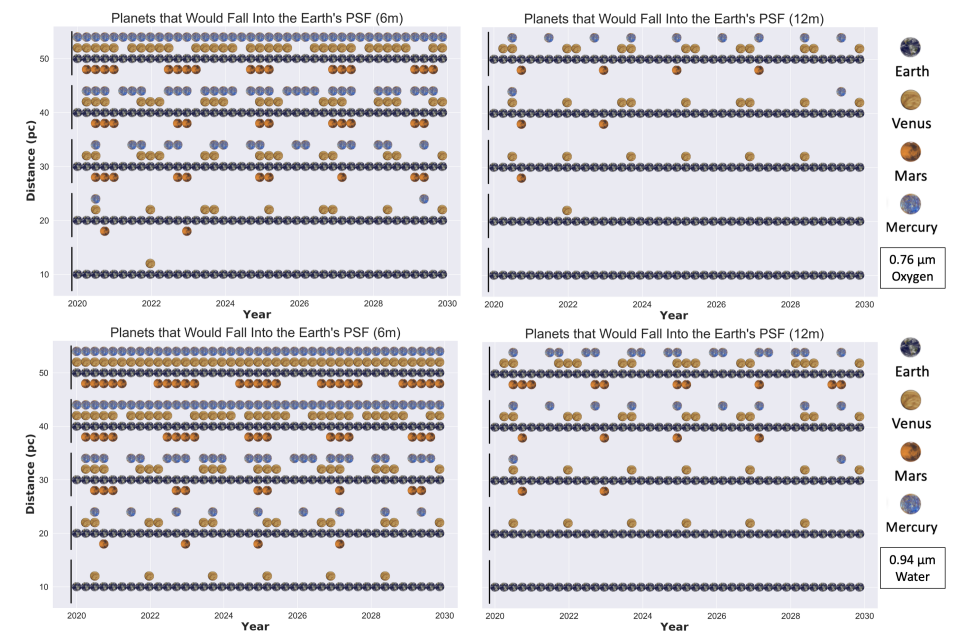and the distribution of digital products.
DM Television
How Planets 'Photobomb' Earth's View in Space Telescope Observations
- Diffraction Limit Comparisons for Future Telescopes
- Photobombing in our Solar System
- Consequences for Obtained Spectra
- Mitigation Strategies and Discussion, and References
Our calculations shown in figure 1 showed that the diffraction limit of a 6m telescope may result in large PSF sizes compared to HZ widths. We calculated how our solar system and the Earth’s PSF would look if it were observed by a similar telescope at different distances in the range used to generate a sufficient Exo-Earth yield. We examined what planets would fall into the Earth’s PSF based upon their time variable distances to the Earth from 2020-2030. We counted any planet closer to the Earth than the diffraction limit distance as a ’photobombing’ planet. We used the Skyfield program (Rhodes 2019) to calculate daily planet positions and distance to Earth for Mercury, Venus, and Mars. The Moon always falls into the Earth’s PSF for the distances we examined.
\ Figure 2 shows what planets fall into the Earth’s diffraction-limited PSF using a 6m telescope and also 12m telescope from 10, 20, 30, 40 and 50 parsecs away, while table 1 shows how many days each planet would photobomb Earth in each year. The top/bottom panels of figure 2 and sections of table 1 correspond to the 0.76 µm/0.94 µm oxygen and water absorption features, which are of high interest for determining habitability and similarity to Earth. Which planets photobomb a particular PSF is wavelength dependent. The Earth is always in the PSF and is the constant line across plots at different distances, with Mercury, Venus and Mars displayed next to the Earth if they are close enough
\

\ be blended into the Earth’s PSF at that time. The figures based on assumptions that the system is being viewed face on (the best case scenario in terms of limiting the duration of photobombing of Earth), and that anything that falls into the diffraction limit distance is considered a photobomb, regardless of whether it may be visible relative to the drop off in flux from the central peak. Each vertical set of planet points along the x-axis in figure 2 corresponds to a date 90 days from the previous one, during which a planet may move in/outside the PSF - this photobombing frequency corresponds strongly to total time a planet falls into the Earth’s PSF, as demonstrated by total photobombing times given in table 1.
\ Key points from this analysis include:
\
Photobombing of Earth by neighboring planets is a common occurrence past 10 parsecs for a 6m telescope. There are < 30 stars within 10 parsecs of a somewhat similar stellar type as the Sun. If Exo-Earths exist in systems similar to our own, it will be common to have additional planets contained in an Exo-Earth’s PSF at numerous wavelengths of interest at distances exceeding 15 parsecs. This changes for a 12m telescope, which has the angular resolution to distinguish many photobombing planets.
\
Photobombing of Earth by neighboring planets observed from > 20 parsecs and farther is persistent over time. In the water band at 20 parsecs, an additional planet photobombs Earth’s PSF ≈ 50% of the time (See table 1 for individual planet durations). This is lower at shorter wavelengths, but more common for longer wavelengths relevant to critical NIR signatures. At larger distances of observation, photobombing should be considered a potential regular occurrence over time.
\
Time varying multi-wavelength observations may be able to extricate photobombing signatures, but are complicated by the likelihood multiple and different planets may be in the Earth’s PSF simultaneously and that photobombing duration from one planet can vary from year to year. Additionally, the Moon will continuously photobomb the Earth, and each of the bodies in the PSF may exhibit time variable spectra due to intrinsic spatial variation of bodies’ spectra. This is further complicated if realistic system and planetary properties such as phase and inclination varying albedo are included.
\
:::info Author:
(1) Prabal Saxena, CRESST II/University of Maryland, College Park, Maryland 20742, USA and NASA Goddard Space Flight Center, Greenbelt, Maryland 20771, USA ([email protected]).
:::
:::info This paper is available on arxiv under ATTRIBUTION-SHAREALIKE 4.0 INTERNATIONAL license.
:::
\
- Home
- About Us
- Write For Us / Submit Content
- Advertising And Affiliates
- Feeds And Syndication
- Contact Us
- Login
- Privacy
All Rights Reserved. Copyright , Central Coast Communications, Inc.